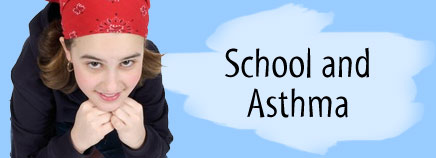
An estimated 7 million U.S. kids under age 18 have been diagnosed with asthma and more than 13 million days of school are missed each year because of the condition, according to the American Academy of Allergy, Asthma, and Immunology.
But well-managed asthma is far less likely to result in a sick day. When kids’ asthma is under control, they have a minimum of flare-ups and fewer problems between them.
Other benefits of proper asthma control include helping kids to:
- sleep well at night and focus at school during the day
- spend time at school in the classroom, not the nurse’s office
- avoid anxiety or embarrassment about flare-ups and asthma symptoms
- study, run, play sports, and fully participate in all school activities
Creating an Asthma Action Plan
So how do you get your child’s asthma under control? The first step is to work with your doctor to create and implement a written asthma action plan that may include a list of:
- the medications your child takes and their dosages
- your child’s asthma triggers
- early symptoms of a flare-up
- what to do if your child is having a flare-up, including when to seek emergency care
The plan might also include instructions for peak flow monitoring and recommendations for dealing with exercise-induced asthma.
Communicating With Your Child’s School
 Once you and the doctor have completed the asthma action plan, make sure to give your child’s school a copy. A meeting with your child’s teacher and other school staff at the start of every school year can also be helpful for making sure that arrangements are in place.
Once you and the doctor have completed the asthma action plan, make sure to give your child’s school a copy. A meeting with your child’s teacher and other school staff at the start of every school year can also be helpful for making sure that arrangements are in place.
You should talk about:
- the history of your child’s asthma
- how independently your child is able to manage the asthma
- how to reach you and your child’s doctor
- plans for handling treatment during any off-site activities, such as field trips
- what the school’s rules are about medication for kids old enough to handle monitoring and treatment at school (can kids keep an inhaler on hand or do they have to go the health office to use it?)
- who handles asthma medications at the school if your child isn’t old enough to take care of monitoring and treatment. Someone on the school’s staff should know how to work the peak flow meter and how to administer medications if your child can’t do it alone. Ideally, a health professional at the school will do this. If not, find out who will.
A supportive environment that helps kids assume responsibility for their own care is an important part of asthma management. Without it, kids might avoid taking their medications or using their peak flow meters. Encourage the school’s staff to help your child settle into a routine that’s efficient and low-key.
Handling Flare-Ups at School
Ideally, quick-relief medicine (also called rescue or fast-acting medicine) should always be immediately available to kids. This means that for kids who aren’t old enough to self-administer the medicine, the teacher will have it in the classroom or it will be readily available (not under lock and key) in the school nurse’s office.
Once kids are old enough to recognize symptoms and know how and when to take their medication, they should carry it at all times, if the school permits. Your doctor can help you determine at what point your child can be responsible for the medication.
Talk to school administrators and find out what they’re willing to allow. Stress the importance of immediate treatment during an asthma flare-up. Administrators may allow your child to self-medicate, but might ask you to sign an “asthma contract,” indicating that you’ve given permission for this to happen and also listing which school personnel are permitted to give your child medication.
Kids who have exercise-induced asthma should have their quick-relief medicine available before any strenuous play or exercise. So they might need permission to go to the nurse’s office before recess or gym class, which may be embarrassing and cumbersome for older kids. Again, it might be better for these kids to carry the quick-relief medicine with them.
Is your child responsible and organized enough to carry the inhaler at all times and to use it when necessary? If so, you can help by reminding your child to have it on hand. Keep track of how much medicine is left in the inhaler, and consider asking to keep extra quick-relief medicine in the nurse’s office, just in case.
Dealing With Triggers at School
Kids are likely to encounter these possible asthma triggers at school:
- mold
- dust mites
- cockroaches
- chalk dust
- perfumes
- cleaning products or other chemicals
- animal dander, saliva, or urine
You should let the school’s staff know if any of these will trigger your child’s asthma. You might also want to make some suggestions, such as:
- Ask teachers to use “dustless” chalk or dry-erase boards.
- Ask the staff to avoid using perfumed cleaning products or soaps.
- Propose the use of air conditioners and dehumidifiers.
- Ask that any classroom where art supplies are used and locker rooms where mold can grow be well ventilated.
- Make sure that the school is vacuumed and dusted regularly, that it’s routinely treated by a pest control company, and that it’s completely smoke free.

